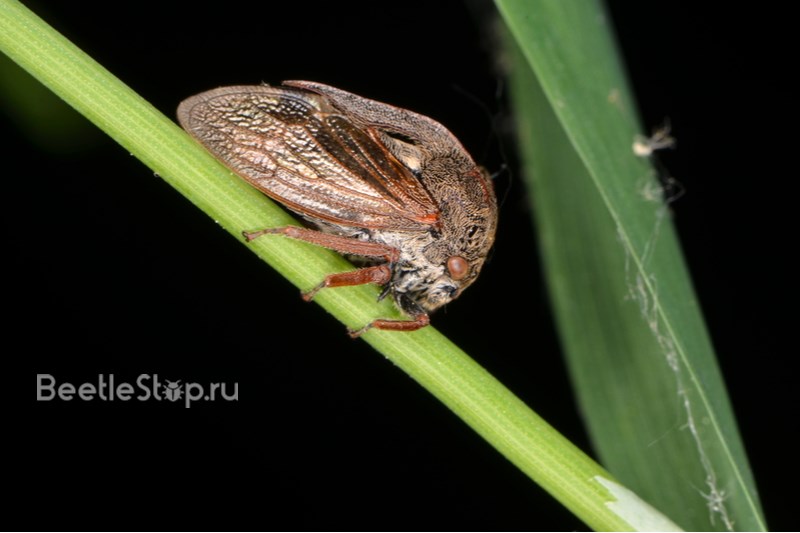Humpbacked humpback - a fantastic inhabitant of raspberry
Small relatives of cicadas, belonging to the order of the winged, surprise the lovers of the fauna with their unusual appearance. Their enlarged pronotums with horns and outgrowths give the insects fantastic shapes. The greatest variety of humpbacks lives in the tropics, but temperate latitudes are not deprived of the unique creations of nature. In the territory from Western Europe to Primorye, as well as in Central Asia, there is a horned humpback. Adult individuals up to 1 cm in size live on poplar, oak, living hedges and raspberries.

Morphological description of the species
An ordinary humpback (Centrotus cornutus) is called a soup or humpbacked humpback. She has a stocky body of brownish-brown color with two outgrowths on the pronotum. Between the long horns, directed in different directions, passes the middle keel. It is a long narrow process ending on the back. The wavy shape with a sharp tip resembles a fabulous cap. The length almost reaches the edge of the abdomen. Structural features are clearly visible when viewed from the side.
Information. The size of an adult is 7–9.6 mm; females are larger than males.
Pads belong to the order of half-winged insects. Their characteristic features: incomplete transformation, the front pair of wings is half leathery, half webbed. Elytra and wings transparent with brown veins. In the world there are more than 3 thousand species representing an exotic family. In the Palearctic, only a small part is found - 70 species. The relationship of the horned to cicadas manifests itself in the structure of the limbs. Hind legs hopping, legs 3-segmented.
Information. The damselfly, to which the horned humpback belongs, at rest dormantly folds its wings, equal along the entire length.
The head is wide, triangular in shape. It is pulled into the prothorax to the very eyes. Mouth organs of piercing-sucking type. The base of the proboscis is located at the posterior edge of the head. In a calm state it is bent. The eyes are large, bulging. The head and body are covered with yellow hairs. Legs are short, denticles on tibia, paws end with claws. This structure makes it easier to crawl through the trees.
Interesting fact. Scientists believe that outgrowths on the humpback body are a modified third pair of wings.
Distribution area
The humpback is a typical palearctic species. Insects are found in most of Europe, in Turkey, Central Asia and Kazakhstan. In Russia they live in European regions, Transcaucasia, Siberia, Khabarovsk and Primorsky Krai.
Lifestyle
The period of activity of insects in Europe and warm regions of Asia from May to September. Adult specimens mostly sit motionless on trees or shrubs and suck plant sap. Habitats of cicadas and fringes of deciduous forests, forest roads, meadows with large herbaceous plants. They prefer young plantations. The humpback is not a highly specialized phytophage; it feeds on various plants.
Horned pads can be found in thickets of raspberries or blackberries. Due to the small size and dark color, it is rather difficult to notice their branches.When a person approaches, insects do not try to carefully and imperceptibly move to the other side of the branch. From direct contact, the humpback bounces and flies off several meters.
Humpbacks move mainly with the help of limbs, but they have not forgotten how to fly. Sometimes, in search of a pair, males make heavy flights, chirping with webbed wings. Insects keep in groups, on one branch you can find adults, nymphs and larvae. Interestingly, when natural enemies attack young animals, females try to drive off predators, pushing them with a wide pronotum with horns. The group of humpbacks does not reach a huge number as a colony of aphids, therefore it does little harm to trees.
Breeding
Mating time for insects is the end of June. The two-year development cycle. Females lay eggs under the bark of trees, in the stems and roots of herbaceous plants. The masonry remains to winter. To protect the offspring from the weather and frost, the female covers the eggs with a special secret. In air, the liquid hardens and forms a solid shield. Larvae appear in spring. Young bodysuits prefer to eat thistle, nettle, and bodyap juice. Outwardly, the offspring is very similar to the parents, but the larvae are devoid of elytra.
Older larvae are called nymphs. They developed a symbiosis with ants. The offspring of humpbacked eggs secrete a sweet liquid that attracts black forest ants, which in turn protect the nymphs from predatory insects. There is no chrysalis stage in the pads, dropping the skin after the last molt, the nymph turns into an adult.

